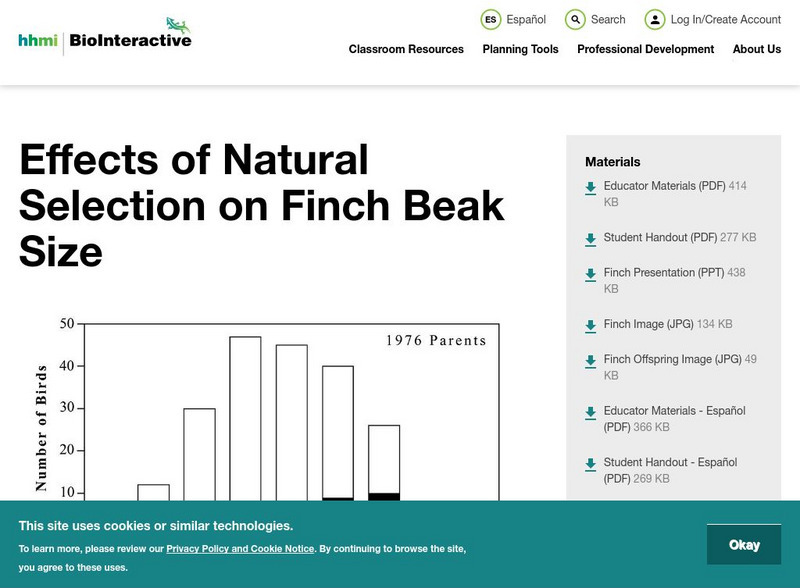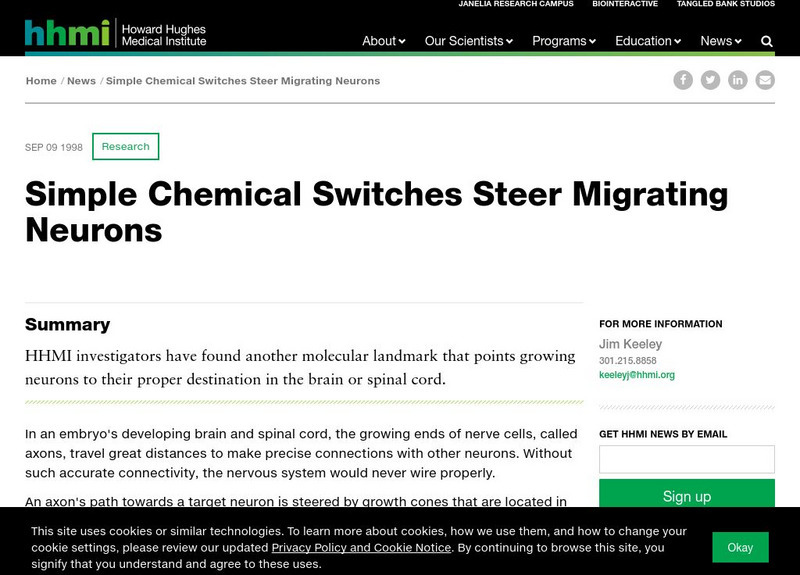Howard Hughes Medical Institute
Hhmi: Biointeractive: Virtual Transgenic Fly Lab
A fantastic interactive laboratory in which transgenic flies are created and used to study circadian rhythms. Excellent supporting information and resources for teachers and students.
Howard Hughes Medical Institute
Hhmi: Biointeractive: Visualizing Gene Expression
Through a series of videos and narrated animations, learn how evolution affects gene expression in species. Find out how visualizing gene expression can help explain what a specific gene does.
Howard Hughes Medical Institute
Hhmi: Biointeractive: The Virtual Neurophysiology Lab
Investigate the nervous system by looking at nerve cells in this virtual lab. This lab exercise allows students to experience a virtual dissection of a leech to use electronic equipment to explore the electrical activity of nerve cells....
Howard Hughes Medical Institute
Hhmi: Biointeractive: Earth Viewer
Watch the earth change with this interactive app? What did Earth look like 250 million years ago? Or 1 billion years ago? Or 4.5 billion years ago? What was the climate like in the deep past? Find the answers with EarthViewer, an...
Howard Hughes Medical Institute
Hhmi: Bio Interactive: Effects of Natural Selection on Finch Beak Size
In this activity, students examine research on finches on the island of Daphne Major in the Galapagos Islands. The depth of the finches' beaks was measured before and after a drought. This data is displayed in graphs and students are...
Howard Hughes Medical Institute
Hhmi: Bio Interactive: Pocket Mouse Film With Quiz
Learn about selective pressure and how genes are involved in adaptations by watching this video on pocket mice. The video focuses on the research of Dr. Michael Nachman, "whose work in the field and in the lab has quantified the...
Howard Hughes Medical Institute
Hhmi: Bio Interactive: Bacterial Id Virtual Lab App
This app will help students "learn about the science and techniques used to identify different types of bacteria based on their DNA sequences".
Howard Hughes Medical Institute
Hhmi: Biointeractive: Molecular Structure of Fat
A comprehensive slideshow illustrating and explaining fat. Learn the structure and impact on the body.
Howard Hughes Medical Institute
Hhmi: Biointeractive: The Immunology Lab
In this lab, students perform a virtual ELISA (enzyme-linked immunosorbent assay)to test whether a particular antibody is present in a blood sample. Students engage in key science practices, including experimental design and data...
Howard Hughes Medical Institute
Hhmi: Cool Science for Kids: Butterflies Come From?
Hands-on activity for investigating the life stages of a butterfly.
Howard Hughes Medical Institute
Hhmi: Biointeractive: Schooling Behavior Stickleback Fish From Different Habitats
A team of scientists studied the schooling behavior of threespine stickleback fish by experimentally testing how individual fish responded to an artificial fish school model.
Howard Hughes Medical Institute
Hhmi: Ask a Scientist
Ask questions about any topic in biology and receive an e-mail response within two weeks. There is an archive of "Top 10 Questions" and responses for each of the following topics: animals, human biology, general biology, evolution,...
Howard Hughes Medical Institute
Hhmi: Simple Chemical Switches Steer Migrating Neuron
Page is describing the chemistry that drives the direction of neuron growth in developing nervous systems. Interesting background to knowledge of neuron growth and neurons in general.
Howard Hughes Medical Institute
Hhmi: Biointeractive: Molecular Mechanism of Synaptic Function
See how electrical and chemical signals are used by neurons to communicate with one another at synapse contact points. [1:09]
Howard Hughes Medical Institute
Hhmi: Bio Interactive: Imatinib (Gleevec)
This interactive shows a 3D model of a drug that acts like ATP and inhibits BCR-ABL, Imatnib (Gleevec). There is also a STL file available for download to print this model.
Howard Hughes Medical Institute
Hhmi: Bio Interactive: Teacher Guide: Ap Biology
Because the biological sciences are constantly changing, this guide helps the AP Biology teacher keep up-to-date on classroom resources that can help enhance the classroom experience. Major resources include the Howard Hughes Medical...
Howard Hughes Medical Institute
Hhmi: Bio Interactive: Article: "The Day the Mesozoic Died"
A short article by Dr. Sean B. Carroll detailing the discoveries covered in the film The Day The Mesozoic Died.
Howard Hughes Medical Institute
Hhmi: Bio Interactive: Feeding a Hungry Heart
An intricate three-dimensional network of blood vessels nourishes the heart. Images like this can be used to make detailed comparisons of healthy and diseased hearts.
Howard Hughes Medical Institute
Hhmi: Biointeractive: The Making of Mass Extinctions
This interactive module explores the environmental factors and species involved in five major mass extinctions.
Howard Hughes Medical Institute
Hhmi: Biointeractive: Understanding Global Change
Students will build models that explain how small changes in the Earth system's components and processes can produce measurable global effects.
Howard Hughes Medical Institute
Hhmi: Bio Interactive: Structure and Function of Telomeres
Discover the cutting edge research going on with telomeres. Find out what they are, how they replicate and their role in the aging process.

















